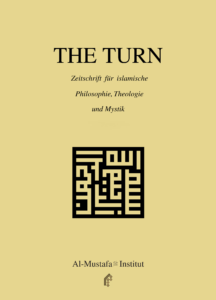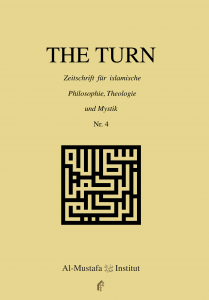„The Turn“ – Open Access Journal
The Turn is an “Open-Access” Journal for islamic philosophy, theology und mystisicm.
The journal is biannually and costs in printed form 10 Euros (8 Euros by subscription).
Email adress for subscrption: info@almustafa.de.
German version / Deutsche Version
Contents
Publisher
Al-Mustafa Institut Berlin
Editorial Staff
Dr. Markus Fiedler
Michael Nestler
Prof. Dr. Mahdi Esfahani
ISSN 2569-2054
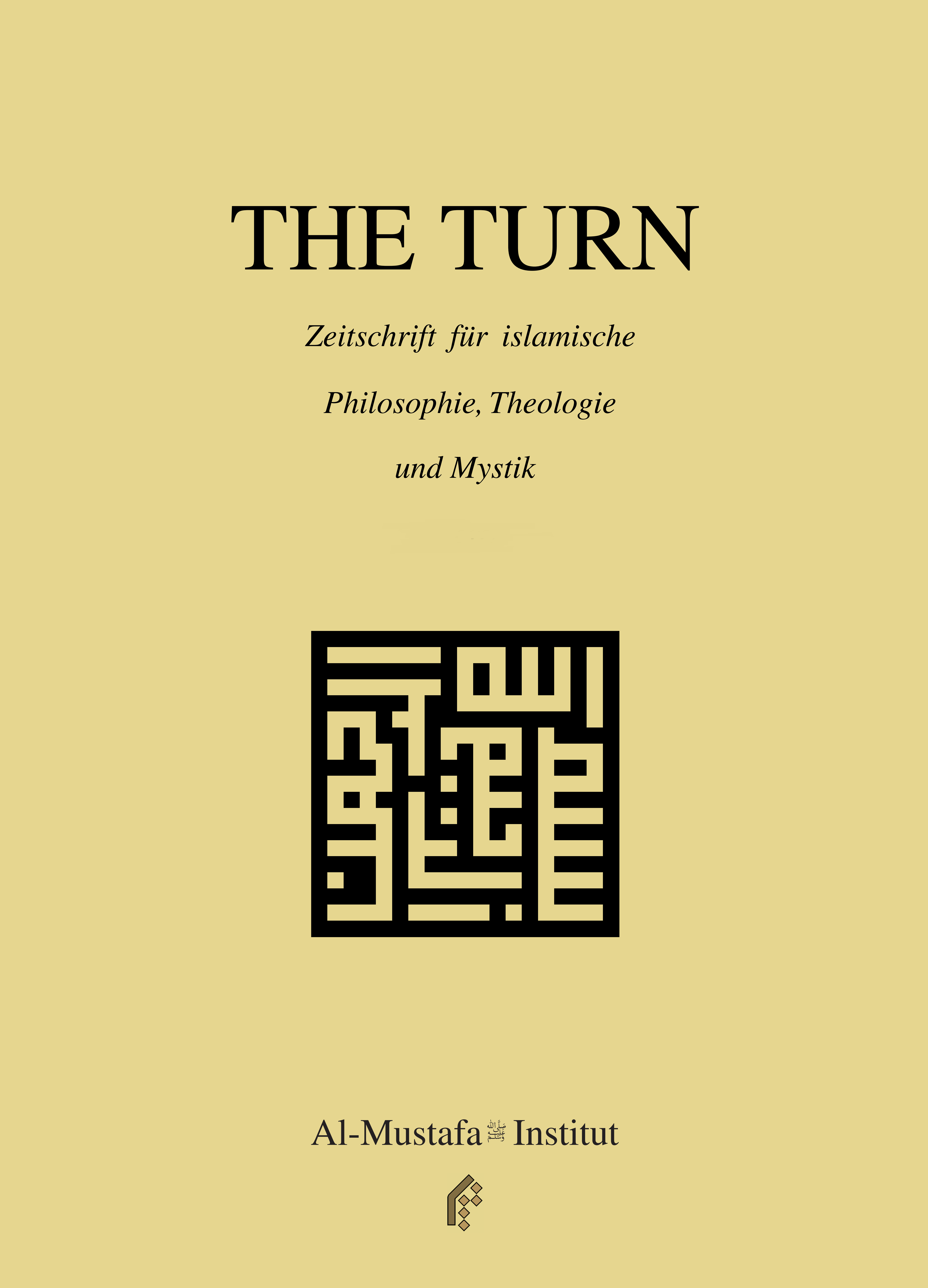
Voulmes and Issues
Ausgabe Zero - Daseinsgrenzen
Titel: Daseinsgrenzen
Erscheinung: Februar 2018
Herausgeber
- Prof. Dr. Mahdi Esfahani (Geschäftsführer des Instituts)
- Dr. Osman Hajjar (Redaktion)
- Michael Nestler (Lektorat)
Ausgabe 1 - Sinn und Unsinn
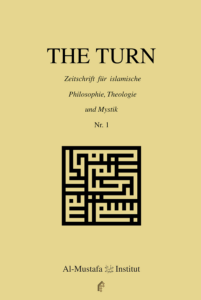
Erscheinung: Oktober 2018
Herausgeber:
- Prof. Dr. Mahdi Esfahani (Geschäftsführer des Instituts)
- Michael Nestler (Lektorat)
- Zeynep Atris (Layout)
Ausgabe 2 - Sprache und Zeichen
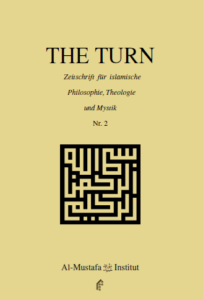
Erscheinung: Dezember 2019
Herausgeber:
- Prof. Dr. Mahdi Esfahani (Geschäftsführer des Instituts)
- Michael Nestler (Lektorat)
- Zeynep Atris (Layout)
Ausgabe 3 - Mensch und Unmensch
Titel: Mensch und Unmensch
Erscheinung: August 2021
Herausgeber:
- Michael Nestler (Lektorat)
- Prof. Dr. Mahdi Esfahani (Geschäftsführer des Instituts)
- Reza Daryaei (Layout)
Ausgabe 4 - Homo ethicus
Titel: Homo ethicus
Erscheinung: Juli 2022
Herausgeber:
- Dr. Markus Fiedler (Lektorat)
- Michael Nestler (Lektorat)
- Prof. Dr. Mahdi Esfahani (Geschäftsführer des Instituts)
- Reza Daryaei (Layout)
Ausgabe 5 - Homo politicus
Titel: Homo ethicus
Erscheinung: Dezember 2022
Herausgeber:
- Dr. Markus Fiedler (Lektorat)
- Michael Nestler (Lektorat)
- Prof. Dr. Mahdi Esfahani (Geschäftsführer des Instituts)
- Reza Daryaei (Layout)
Further Information
About the Journal The Turn — self-image, goals and target group
About / Aim / Scope
The journal The Turn — Journal for Islamic philosophy, theology and mysticism has been published since February 2018 and is edited by the scientific editorial team of the Al-Mustafa Institute Berlin. From 2018 to 2021 the magazine was published once a year; from 2022 onwards it will be published every six months. Each issue of the magazine is linked to a specific topic specified by the editors (previous topics of issues 0-4: “Limits of Existence”, “Sense & Nonsense”, “Language & Signs”, “Human & Non-Human”, “Homo ethicus”) and which largely reflects the triad of philosophy, theology and mysticism. The Turn is contested by Muslim and non-Muslim scholars alike with the aim of jointly reflecting on fundamental questions that inevitably arise in the humanities. In particular, terms such as performative turn, rhetorical turn, postcolonial turn, spatial turn, iconic turn or religious turn, which have been circulating in scientific circles since the 1970s, raise the question of whether Islamic culture still needs its own turn. The magazine The Turn puts this up for discussion and moreover answers in the affirmative: there is no doubt that discourses about Islam have led to a ‘turnaround’ in the West. Political debates in particular constantly revolve around this cultural ‘other’, but it is also playing an increasingly important role in the humanities.
The English term turn is rendered in German as “Wende”, “Kehre”, but also as “Drehung” or “Umdrehung” and initially it cannot be denied that the appearance of the Koran marked a change, a turning point in the world. The appearance and the message of Muḥammad brought Islamic civilization to fruition in a rapid and historically unprecedented process, causing a ‘cultural turning point’ that changed eastern and western knowledge cultures, whether they professed Islam or not. What this turning point consists of to this day and what effects it has in detail is the central subject matter of the magazine, which at the same time tries to draw larger thematic circles so that other traditions of thought and other interpretations of life are included in the discussion. Therefore, The Turn sees itself as a scientific and intercultural forum that offers researchers from various fields of science the opportunity to explore new perspectives on the questions raised by Islam and the Koran and to enter into dialogue with one another. However, this should not be a dialogue that constructs borders, but rather a dialogue of thinking and research that does not even ask about cultural and religious affiliations. What the journal strives for is therefore not ‘Islamic scholarship’, but rather writing around Islam, whereby other texts than the Koran, other traditions and other points of view are of course included in the investigations.
With its interdisciplinary articles, The Turn is primarily aimed at an academically educated readership in the humanities who are just as interested in questions of theology, Islamic studies, and oriental studies as they are in questions of philosophy, sociology, psychology and linguistics.
Guide for Authors
Die wissenschaftlichen Artikel sind in Form eines kompletten, publikationsfähigen Manuskripts einzureichen, in deutscher oder englischer Sprache. Die Beiträge dürfen noch nicht publiziert oder zur Veröffentlichung bei einer anderen Zeitschrift eingereicht worden sein. Es wird vorausgesetzt, dass die eingereichten Artikel den üblichen wissenschaftlichen Standards sowie den unter Punkt 2 aufgeführten formellen Vorgaben der Manuskriptgestaltung entsprechen.
Die Manuskripte sind der Redaktion im Word-Format an die folgende E-Mail-Adresse zu schicken: info@almustafa.de.
Der Eingang der Manuskripte wird von der Redaktion bestätigt. Die eingereichten wissenschaftlichen Beiträge werden dann einer näheren Begutachtung unterzogen und hinsichtlich des von der Redaktion vorgegebenen allgemeinen Themas für jede neue Ausgabe auf ihre wissenschaftliche Fundierung, Relevanz der Fragestellung, Originalität, Methodik und Klarheit bzw. Genauigkeit in der Darstellung hin überprüft. Auf Grundlage dieser Begutachtung entscheidet die Redaktion über Annahme, eventuelle Auflagen zur Überarbeitung oder Ablehnung des jeweiligen Beitrags.
Die AutorInnen erhalten nach Veröffentlichung jeweils drei Belegexemplare der Ausgabe, in der ihr Artikel erschienen ist.
Außerdem wird jeder veröffentlichte Artikel mit einer DOI-Kennung versehen, die dann dauerhaft mit dem Beitrag verbunden ist.
- Formelle Vorgaben für die Manuskriptgestaltung
- Textumfang: → Artikel 30 Seiten; → Tagungs- bzw. Forschungsberichte, Rezensionen, Essays usw. max. 5-7 Seiten.
- Textformatierung: → Standardeinstellungen: Seitenränder: oben, unten, links, rechts: 2,5 cm; Schriftart: Times New Roman; Schriftgröße: bei Überschriften (Hauptkapitel) 14 pt., bei Überschriften (Unterkapitel) sowie im Fließtext 12 pt., längere Zitate (40 Wörter und mehr) 11 pt., Fußnoten 10 pt; Zeilenabstände: im Fließtext 1,5, bei längeren Zitaten und in den Fußnoten 1,0; Textausrichtung: Blocksatz. Am Anfang bzw. Ende eines jeden Absatzes ist ein einfacher Abstand hinzuzufügen (siehe auch Zitate mit mehr als 40 Wörtern) und die erste Zeile eines neuen Absatzes erhält links im Fließtext einen weiteren Einzug um 0,5 cm.
- Zitate: → Wörtliche Zitate unter 40 Wörter im Fließtext: doppelte Anführungszeichen unten/oben (z. B. „Text“; für englische Texte entsprechend “text”); bei Zitaten innerhalb eines Zitats einfache Anführungszeichen, unten/oben (z. B. ‚Gremium‘). Abschließende Satzzeichen stehen dann vor dem abschließenden Anführungszeichen, wenn sie sich tatsächlich im zitierten Text nachweisen lassen. Auslassungen innerhalb eines Zitats werden durch drei Punkte in einer eckigen Klammer ([…]) gekennzeichnet; auf Textparaphrasen ist in den Fußnoten mit dem Kürzel „Vgl.“ zu verweisen; → Zitate mit mehr als 40 Wörtern: im Blocksatz, mit einem Einzug rechts und links vom Fließtext um jeweils 0,5 cm sowie mit einem zusätzlichen Absatzabstand vor und nach dem Zitat; Schriftgröße: 11 pt.; Zeilenabstand: 1,0.
- Angaben zur Literatur: Angaben zur Literatur gehören grundsätzlich nicht in den Fließtext, sondern in die Fußnoten bzw. in das Literaturverzeichnis. Die vollständigen Angaben zur verwendeten Literatur sowie Internetlinks mit Angabe des genauen Abrufdatums erfolgen am Ende eines jeden Beitrags in einem ausführlichen und alphabetisch angeordneten Literaturverzeichnis ungefähr nach folgendem Schema:
Name, Vorname (Jahr der Veröffentlichung): Titel. Untertitel. Ort (ggf. davor Reihen- und Bandangabe, Auflage, sowie Angaben zur Herausgeberschaft oder danach Angaben zu Seitenzahlen und genaue URL mit letztem Zugriffsdatum).
Hier einige Beispiele:
Boyarin, Daniel (1990): History becomes parable: a reading of the midrashic mashal. In: Tollers, Vincent L./Maier, John (Hrsg.): Mappings of the Biblical Terrain: The Bible as Text. Lewisburg. S. 54-71.
Busse, Heribert (2001): Cain and Abel. In: McAuliffe, Jane Dammen (Hrsg.): Encyclopaedia of the Qurʾān. Leiden [u. a.]. Bd. 1, S. 270-272.
Neuwirth, Angelika (2007): Studien zur Komposition der Mekkanischen Suren. 2. Aufl. Berlin/New York.
Shaki, Mansour (2001): Gayōmart. In: Yarshater, Ehsan (Hrsg.): Encyclopaedia Iranica. New York. Bd. 10, S. 345-347. Online: http://www.iranicaonline.org/articles/gayomart. Zugriff: 16.11.2020.
Fußnoten: Die Angaben der verwendeten Literatur in den Fußnoten werden grundsätzlich mit Kurztiteln wiedergegeben und folgen diesem Schema:
Name Erscheinungsjahr, evtl. Bandangabe, Seitenzahl.
Beispiele:
Boyarin 1990, S. 54-71.
Busse 2001, Bd. 1, S. 270-272.
| Wichtiger Hinweis: Die AutorInnen zeichnen sich selbst verantwortlich für die korrekte Angabe von Literatur, Internetquellen und Zitaten! |
- Transkription: Für die Transkription bzw. Transliteration arabisch-, persisch- sowie osmanisch-sprachiger Texte und Termini gelten allgemein die Umschriftregeln der Deutschen Morgenländischen Gesellschaft (DMG). Entsprechende Leitlinien und nähere Informationen darüber, wie hier im Einzelnen bei Begriffen, Eigennamen, Buchtiteln sowie längeren Textzitaten vorzugehen ist, können bei Bedarf den AutorInnen von der Redaktion zur Verfügung gestellt werden, sind aber auch im Internet einsehbar (z. B. hier uni-bamberg.de/fileadmin/uni/fakultaeten/split_faecher/orientalistik/Dateien/Translit.pdf).
Bei Begriffen und Texten aus anderen akademischen Fachbereichen sind die dort jeweils geltenden wissenschaftlichen Regeln und allgemeinen Standards zur Umschrift anzuwenden.
- Rechtschreibung: Es gelten die Regeln der neuen deutschen Rechtschreibung.
- Zusätzliches zum Manuskript: Neben dem Manuskript sind eine Zusammenfassung des Artikels auf Deutsch bzw. Englisch (ca. 300-400 Wörter) mit einzureichen sowie eine AutorInnen-Biographie mit Angaben zum akademischen Werdegang, zu Funktionen bzw. Tätigkeiten und zu den aktuellen Forschungsschwerpunkten (max. 200 Wörter). Darüber hinaus ist auch nochmal die genaue E-Mail-Adresse anzugeben sowie eine aktuelle Postanschrift, an die die Belegexemplare nach Veröffentlichung der Zeitschrift gesendet werden können.
Quality assurance / peer review process
- Procedure for the first four issues of The Turn
For the editors of The Turn, the quality of the articles that appear in the journal is a top priority — after all, the scientific standards of the journal stand or fall with it.
For issues 0-4, our editorial team invited renowned scientists to write an article for our journal. The articles sent were first checked in terms of content and form by our team of editors, and any objections were then discussed with the authors. Any contributions that needed to be revised were returned to the authors for correction, which then led to another check by the editors. This solved problems in the interaction between the editors and the authors.
- Double blind review procedure
Since the 5th edition of The Turn, the double blind review procedure has been added to the procedure described above. Two reviewers (peers) read the article without knowing the names of the authors, who in turn do not know the identity of the peers. The reviewers (peers) are scientists who are experts in their respective fields and therefore have the appropriate qualifications to evaluate an article. The double blind review process decides whether or not a contribution will be accepted by the editors for publication in The Turn. The reviewers (peers) should also submit any suggestions for improvement and point out deficiencies that may necessitate a revision of the article in question by the authors.
- The reviewers (peer reviewers)
Before reviewing the article in question, the reviewers should disclose whether they have (e.g. financial) interests or pursue activities that may complicate the review. Reviewers are encouraged to report to the editors any such interest or activity that interferes with an independent review of the manuscripts. If there is a risk of bias, the review of certain manuscripts should be refrained from. Reviewers must not use their knowledge of the work they are reviewing to further their own interests prior to its publication.
- Legal notice
4.1 Disclaimer
The Turn aims to use its website to provide information about its quality assurance goals and procedures. The information presented here is of a general nature and has no specific reference to specific persons or institutions. Although we endeavor to provide the relevant information correctly, it is not necessarily comprehensive, complete, correct or up-to-date. If we become aware of any errors, we will endeavor to rectify them as quickly as possible.
4.2 Disclaimer for external links
Despite careful content control, we assume no liability for the content of external links. The operators of the linked pages are solely responsible for their content.
4.3 Privacy
The Turn is committed to the principle of data protection.
Data protection is of a particularly high priority for the editors of The Turn. The use of the website of The Turn is essentially possible without any indication of personal data.
If the processing of personal data is necessary (e.g. for subscriptions, authors, etc.) and there is no legal basis for such processing, we generally obtain the consent of the persons concerned.
The processing of personal data, such as the name, address, e-mail address, or telephone number of a data subject, shall always be in line with the General Data Protection Regulation (GDPR), and in accordance with the country-specific data protection regulations applicable to The Turn. By means of this data protection declaration, our journal would like to inform the public about the type, scope and purpose of the personal data we collect, use and process. Furthermore, data subjects are informed of the rights to which they are entitled by means of this data protection declaration. As the controller, The Turn has implemented numerous technical and organizational measures to ensure the most complete protection of personal data processed through this website. Nevertheless, Internet-based data transmissions can generally have security gaps, such that absolute protection cannot be guaranteed. For this reason, every person concerned is free to transmit personal data to us in alternative ways, for example by telephone.
4.3.1 Definitions
The data protection declaration of The Turn is based on the terms used by the European legislator for the adoption of the General Data Protection Regulation (GDPR). Our data protection declaration should be legible and understandable for the public as well as for our authors and readers. To ensure this, we would like to explain the terms used in advance.
We use the following terms, among others, in this data protection declaration:
- a) Personal data
Personal data is all information that relates to an identified or identifiable natural person (hereinafter “data subject”). A natural person is considered to be identifiable if, directly or indirectly, in particular by means of assignment to an identifier such as a name, an identification number, location data, an online identifier or to one or more special features, the expression of the physical, physiological, genetic, psychological, economic, cultural or social identity of this natural person can be identified.
- b) Data subject
Data subject is any identified or identifiable natural person whose personal data is processed by the data controller.
- c) Processing
Processing is any process carried out with or without the help of automated procedures or any such series of processes in connection with personal data such as collecting, recording, organizing, organizing, storing, adapting or changing, reading out, querying, using, disclosure by transmission, distribution or any other form of making available, matching or linking, restriction, deletion or destruction.
- d) Restriction of processing
Restriction of processing is the marking of stored personal data with the aim of restricting their future processing.
- e) Profiling
Profiling is any type of automated processing of personal data that consists in using this personal data to evaluate certain personal aspects relating to a natural person, in particular aspects relating to work performance, economic situation, health, personal preferences, interests, reliability, behavior, whereabouts or relocation.
- f) Pseudonymization
Pseudonymization is the processing of personal data in such a way that the personal data can no longer be assigned to a specific data subject without the use of additional information, provided that this additional information is kept separately and is subject to technical and organizational measures that ensure that the personal data is not assigned to an identified or identifiable natural person.
- g) Controller or data controller
The person responsible or responsible for processing is the natural or legal person, authority, institution or other body that alone or jointly with others decides on the purposes and means of processing personal data. If the purposes and means of this processing are specified by European Union law or the law of the Member States, the person responsible or the specific criteria for his or her naming can be provided for by European Union law or the law of the Member States.
- h) Processor
Processor is a natural or legal person, public authority, institution or other body that processes personal data on behalf of the person responsible.
- i) Recipient
Recipient is a natural or legal person, public authority, institution or other body to which personal data is disclosed, regardless of whether it is a third party or not. However, authorities that may receive personal data in the context of a specific investigation mandate under European Union or Member State law are not considered recipients.
- j) Third party
Third party is a natural or legal person, public authority, agency or body other than the data subject, the controller, the processor and the persons who, under the direct responsibility of the controller or the processor, is authorized to process the personal data.
- k) Consent
Consent is any expression of will voluntarily given by the data subject in an informed manner and unequivocally for the specific case in the form of a declaration or other clear confirmatory action with which the data subject indicates that they consent to the processing of their personal data.
- 3.2 Name and address of the data controller
The person responsible within the meaning of the General Data Protection Regulation, other data protection laws applicable in the member states of the European Union and other provisions of a data protection nature, is:
The Turn, ed. by the Al Mustafa Institute in Berlin
(Address below under 4.4)
4.3.3 Cookies
The Internet pages of The Turn use cookies. Cookies are text files that are filed and saved on a computer system via an Internet browser.
Numerous websites and servers use cookies. Many cookies contain a so-called cookie ID. A cookie ID is a unique identifier of the cookie. It consists of a character string through which websites and servers can be assigned to the specific Internet browser in which the cookie was stored. This enables the visited websites and servers to distinguish the individual browser of the person concerned from other Internet browsers that contain other cookies. A specific Internet browser can be recognized and identified via the unique cookie ID.
Through the use of cookies, The Turn can provide the users of this website with more user-friendly services that would not be possible without the cookie setting.
By means of a cookie, the information and offers on our website can be optimized for the user. As already mentioned, cookies enable us to recognize the users of our website. The purpose of this recognition is to make it easier for users to use our website. For example, the user of a website that uses cookies does not have to re-enter their access data each time they visit the website because this is done by the website and the cookie stored on the user’s computer system.
The person concerned can prevent the setting of cookies by our website at any time by means of a corresponding setting in the Internet browser used and thus permanently object to the setting of cookies. Furthermore, cookies that have already been set can be deleted at any time via an Internet browser or other software programs. This is possible in all common Internet browsers. If the person concerned deactivates the setting of cookies in the Internet browser used, not all functions of our website may be fully usable.
- 3.4 Collection of general data and information
The Website collects a range of general data and information when an individual or an automated system calls up the website. This general data and information is stored in the log files of the server. The date that can be recorded includes:
(1) browser types and versions used, (2) the operating system used by the accessing system, (3) the website from which an accessing system accesses our website (so-called referrer), (4) the sub-websites that are accessed via an accessing system controlled by our website, (5) the date and time of access to the website, (6) an Internet protocol address (IP address), (7) the Internet service provider of the accessing system and (8) other similar data and information that serves to avert danger in the event of attacks on our information technology systems.
When using these general data and information, the journal The Turn does not draw any conclusions about the data subject. Rather, this information is required in order to
(1) deliver the content of our website correctly,
(2) optimize the content of our website and the advertising for it,
(3) ensure the permanent functionality of our information technology systems and the technology of our website, as well as
(4) provide law enforcement authorities with the information necessary for law enforcement in the event of a cyber attack. The Turn therefore evaluates this anonymously collected data and information statistically, with the aim of increasing data protection and data security in our company, and ultimately to ensure an optimal level of protection for the personal data we process. The anonymous data of the server log files are stored separately from all personal data provided by an affected person.
4.4 Copyright Notice
© TheTurn, 2022
The Turn is published by the Al-Mustafa Institute Berlin
Responsible i. s.d. P.: Prof. Dr. Mahdi Esfahani (Managing Director of the Al Mustafa Institute)
Koenigsberger Str. 21, 12207 Berlin
: +49 30 40741071
Fax: +49 3040741069
Email: info@almustafa.de
Homepage: www.almustafa.de
Publication ethics
Articles being considered for publication
Contributions can be submitted on topics relevant to The Turn (see “About the journal The Turn — self-image, goals and target group”) that meet the usual scientific standards. Statements made in the contributions must be documented, external sources must be cited and a bibliography must be created.
It should be noted that each edition of The Turn is themed. The manuscript must therefore also be relevant to the current issue and fit the concept. Hence for anyone wishing to write specifically for The Turn, it is always a good idea to get in touch with the editors.
- Notes on submission of manuscripts
The articles must correspond to the usual scientific standards and be provided with references/footnotes and a bibliography. The manuscript is to be submitted in the form of a complete, publishable manuscript — in German or in English.
Further information on the format can be found in the publication guide available on the homepage.
The manuscripts are to be sent to the editors in a Word or LATEX file to the following e-mail address: turn@almustafa.de
The editors will confirm receipt of the manuscripts.
The submitted contributions are then subjected to a more detailed assessment in a double-blind review process with regard to the general topic specified by the editors for each new issue, the scientific foundation of the manuscript, the relevance of the question, originality, methodology, and the clarity or accuracy in the presentation. On the basis of this review, the editorial team decides whether to accept the contribution or request a revision on certain conditions.
- Declaration of consent from the authors when the manuscript is sent
By sending their manuscript to the editors, the authors declare their consent to the publication ethics of The Turn and affirm
— that the manuscript has not yet been published or submitted to another journal for publication;
— that the manuscript was written by the author him- or herself and according to scientific standards and that external sources were indicated accordingly.
- Exclusion criteria
4.1 Inconsistency with journal orientation and scholarly deficiencies
The readers of The Turn should be able to rely on the fact that the articles appearing in the journal are consistent with the goals of our journal, correspond to scientific standards and are of high quality.
Manuscripts that do not meet scientific standards and are rejected by our reviewers are therefore excluded from publication.
Furthermore, contributions falling under the following categories are not eligible for publication:
4.2 Duplicate submission
Authors should not submit the same manuscript to more than one journal at the same time. Excluded from this are contributions taken from master’s theses and dissertations.
This is because conflicts can arise when two (or more) journals claim the right to publish an article submitted to them at the same time, resulting in considerable additional work for at least one of the journals.
4.3 Previously published articles
The readers of The Turn should be able to assume that the articles appearing in the magazine are originals.
Duplicate publications are therefore excluded. Submitting an article that has already been published in another newspaper/magazine/on the Internet is not permitted. This also applies to the planned publication of an article that essentially overlaps with an already published contribution without a clear reference to the already existing publication.
The Turn’s editing process includes a plagiarism check.
4.4 Statement of scientific misconduct
Unfortunately, science has never been free from falsification and fraud.
“Scientific misconduct” includes plagiarism, the adoption of someone else’s ideas without citing sources, the manipulation of images or sources, the deliberate deception of the editors by providing false information (names, addresses, academic degrees, etc.) and deliberate concealment of clients, relevant relationships and activities, etc.
The basis for the following statement against author misconduct is international copyright laws, ethical behavior and the cost-effective use of resources.
If the editors of The Turn suspect a case of scientific misconduct, they will initiate an appropriate process, e.g. as described by the Committee on Publication ethics (COPE).
The editorial board reserves the right to publish its evidence of misconduct pending the results of an appropriate investigation. If the suspicion is confirmed by the majority of its members after an investigation by the editorial team, the editorial team will announce this, for example, on their homepage and inform the readers of the magazine.
The editors also reserve the right to inform universities or other scientific institutions and clients of their findings.
If, during the investigation process, there are also proceedings in the institution with which the authors work, the editors will also include the result of this investigation and, if necessary, inform the readers about it.
Should the investigation actually prove scientific misconduct, the retraction of the article will be published and the readers informed.
Kontaktiere uns!

